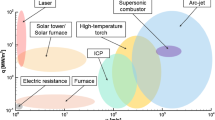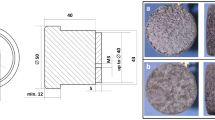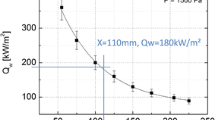Abstract
A porous carbon material with a three-dimensional (3D) networked structure (carbon monolith) was prepared as a substrate for an ablator, which is a thermal protection system (TPS) for re-entry vehicles. A carbon monolith ablator (CMA) was fabricated by impregnating acrylic resin into the carbon monolith. To evaluate the thermal insulation effect of the CMA, arc wind tunnel tests for the carbon monolith and CMA were conducted to simulate atmospheric re-entry. The results indicated that the surface temperature of the CMA was lower than that of the carbon monolith, and the decomposition of the acrylic resin was effective in preventing an increase in surface temperature, as the decomposition of the resin is an endothermic process. Thermal conduction and stress analyses using the finite element method revealed that the tensile stress that evolved during exposure reached those of typical porous carbon materials, and tensile stress relaxation was required to apply the CMA as a TPS.
Graphical abstract





Similar content being viewed by others
Data availability
The datasets generated in this study are available from the corresponding author on request.
References
T. Ogasawara, T. Ishikawa, T. Yamada, R. Yokota, J. Compos. Mater. (2002). https://doi.org/10.1106/002199802023554
S. Sasaki, M. Ishikawa, Y. Kogo, T. Aoki, T. Ogasawara, Y. Ishida, T. Yamada, Fabrication and characterization of ultra-lightweight ablator using porous carbon materials, in: 16th European Conference on Composite Materials, 2014: pp. 1–8.
F.I. Hurwitz, Thermal Protection Systems (TPSs, in: Encyclopedia of Aerospace Engineering, Wiley, 2010: pp. 1–12. https://doi.org/10.1002/9780470686652.eae211.
M. Stackpoole, S. Sepka, I. Cozmuta, D. Kontinos, Post-flight evaluation of stardust sample return capsule forebody heatshield material, in: 46th AIAA Aerospace Sciences Meeting and Exhibit, 2008: pp. 1–6. https://doi.org/10.2514/6.2008-1202.
O. Uyanna, H. Najafi, Acta. Astronaut. (2020). https://doi.org/10.1016/j.actaastro.2020.06.047
M. Schouler, Y. Prévereaud, L. Mieussens, Survey of flight and numerical data of hypersonic rarefied flows encountered in earth orbit and atmospheric reentry, Progress in Aerospace Sciences 118 (2020). https://doi.org/10.1016/j.paerosci.2020.100638.
M.A. Covington, J.M. Heinemann, H.E. Goldstein, Y.K. Chen, I. Terrazas-Salinas, J.A. Balboni, J. Olejniczak, E.R. Martinez, J. Spacecr. Rockets 10(2514/1), 38249 (2008)
P. Agrawal, J.F. Chavez-Garcia, J. Pham, J. Spacecr. Rockets 10(2514/1), A32389 (2013)
B.K. Bessire, S.A. Lahankar, T.K. Minton, ACS Appl. Mater. Interfaces (2015). https://doi.org/10.1021/am507816f
H.K. Tran, C.E. Johnson, D.J. Rasky, F.C.L. Hui, M.T. Hsu, Y.K. Chen, Phenolic impregnated carbon ablators (PICA) for discovery class missions, in: 31st Thermophysics Conference, American Institute of Aeronautics and Astronautics Inc, AIAA, 1996. https://doi.org/10.2514/6.1996–1911.
Y. Arai, Y. Daigo, E. Kojo, R. Inoue, Y. Kogo, Int. J. Appl. Ceram. Technol. 19 (2022) https://doi.org/10.1111/ijac.13930.
Y. Arai, Y. Daigo, K. Esuke, I. Ryo, K. Yasuo, J. Mater. Sci. (2021). https://doi.org/10.1007/s10853-021-05950-x
Y. Kaneda, R. Inoue, Y. Kogo, Development of fabrication procedure of porous carbon material with three dimensionally networked structure, The Proceedings of Mechanical Engineering Congress, Japan 2017 (2017) S0420104. https://doi.org/10.1299/jsmemecj.2017.s0420104.
Y. Kubota, T. Fujita, Y. Kaneda, R. Inoue, Y. Kogo, J. Spacecr. Rockets (2018). https://doi.org/10.2514/1.A34234
Y. Kaneda, R. Inoue, K. Yasuo, Fabrication procedure for porous carbon material with three dimensionally networked structure, in: Ceramic Engineering and Science Proceedings, Wiley-American Ceramic Society, New York, 2019: p. 77. https://doi.org/10.1002/9781119543381.ch9.
R.L. Potts, J. Spacecr. Rockets 10(2514/3), 26597 (1995)
H. Kashani, Y. Ito, J. Han, P. Liu, M. Chen, Sci. Adv. (2019). https://doi.org/10.1126/sciadv.aat6951
H. Weng, H. Zhang, O.U. Khan, A. Martin, Multi-dimensional modeling of charring ablators, in: 43rd AIAA Thermophysics Conference 2012, 2012. https://doi.org/10.2514/6.2013–2635.
Acknowledgments
The results of this study were derived from the arc wind tunnel tests conducted at the Institute of Space and Astronautical Science, Japan Aerospace Exploration Agency (ISAS/JAXA). The authors are grateful to Takayuki Shimoda, Yuma Yagi, and Tetsuo Yoshida for their assistance with these tests.
Funding
This study was supported by a Japan Society for the Promotion of Science (JSPS) KAKENHI Grant-in-Aid for Scientific Research (B) (23H01306) from the Ministry of Education, Culture, Sports, Science, and Technology (MEXT, Japan).
Author information
Authors and Affiliations
Contributions
Conceptualization: YK; methodology: RO, KT; formal analysis and investigation: RO, KT; writing—original draft preparation: RO, YA; writing—review and editing: YA; funding acquisition: YK, YA; resources: YK; supervision: YK, YA.
Corresponding author
Ethics declarations
Competing interests
The authors declare no conflicts of interest.
Additional information
Publisher's Note
Springer Nature remains neutral with regard to jurisdictional claims in published maps and institutional affiliations.
Rights and permissions
Springer Nature or its licensor (e.g. a society or other partner) holds exclusive rights to this article under a publishing agreement with the author(s) or other rightsholder(s); author self-archiving of the accepted manuscript version of this article is solely governed by the terms of such publishing agreement and applicable law.
About this article
Cite this article
Ono, R., Tsukamoto, K., Arai, Y. et al. Experimental and analytical evaluation of an aerospace thermal protection system: Carbon monolith ablator. MRS Advances (2024). https://doi.org/10.1557/s43580-024-00850-z
Received:
Accepted:
Published:
DOI: https://doi.org/10.1557/s43580-024-00850-z




